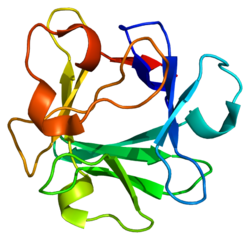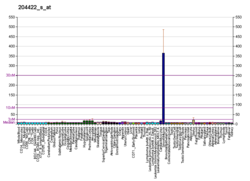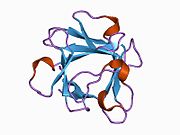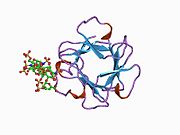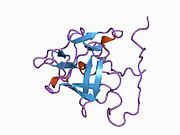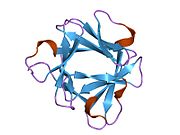Fibroblast growth factor 2
Fibroblast growth factor 2(FGF-2), also known asbasic fibroblast growth factor(bFGF) andFGF-β,is agrowth factorandsignaling proteinencoded by theFGF2gene.[5][6]It binds to and exerts effects via specificfibroblast growth factor receptor(FGFR) proteins,themselves a family of closely related molecules.Fibroblast growth factorprotein was first purified in 1975; soon thereafter three variants were isolated: 'basic FGF' (FGF2); Heparin-binding growth factor-2; and Endothelial cell growth factor-2. Gene sequencing revealed that this group is the same FGF2 protein and is a member of afamily of FGFproteins.[7][8]
Function
[edit]Like other FGF family members, basic fibroblast growth factor possesses broadmitogenicand cell survival activities, and is involved in a variety of biological processes, includingembryonic development,cell growth,morphogenesis,tissue repair,tumor growth and invasion.
In normal tissue, bFGF is present inbasement membranesand in thesubendothelialextracellular matrixofblood vessels.It staysmembrane-bound as long as there is nosignal peptide.
It has been hypothesized that, during bothwound healingof normal tissues andtumordevelopment, the action ofheparan sulfate-degradingenzymesactivates bFGF, thus mediating the formation of newblood vessels,a process known asangiogenesis.
In addition, it is synthesized and secreted by humanadipocytesand the concentration of FGF2 correlates with the BMI in blood samples. It was also shown to act onpreosteoblasts– in the form of an increasedproliferation– after binding tofibroblast growth factor receptor 1and activatingphosphoinositide 3-kinase.[9]
FGF2 has been shown in preliminary animal studies to protect the heart from injury associated with a heart attack, reducing tissue death and promoting improved function afterreperfusion.[10]
Evidence has shown that low levels of FGF-2 play a key role in the incidence of excessive anxiety.[11]
Additionally, FGF-2 is a critical component of humanembryonic stem cellculture medium; the growth factor is necessary for the cells to remain in an undifferentiated state, although the mechanisms by which it does this are poorly defined. It has been demonstrated to inducegremlinexpression which in turn is known to inhibit the induction of differentiation bybone morphogenetic proteins.[12]It is necessary in mouse-feeder cell dependent culture systems, as well as in feeder and serum-free culture systems.[13]FGF-2, in conjunction withBMP4,promote differentiation of stem cells to mesodermal lineages. After differentiation, BMP4 and FGF2 treated cells generally produce higher amounts ofosteogenicandchondrogenicdifferentiation than untreated stem cells.[14]However, a low concentration of bFGF (10 ng/mL) may exert an inhibitory effect onosteoblastdifferentiation.[15]The nuclear form of FGF2 functions in mRNA export[16]
FGF-2 is synthesized primarily as a 155 amino acid polypeptide, resulting in an 18 kDa protein. However, there are four alternate start codons which provide N-terminal extensions of 41, 46, 55, or 133 amino acids, resulting in proteins of 22 kDa (196 aa total), 22.5 kDa (201 aa total), 24 kDa (210 aa total) and 34 kDa (288 aa total), respectively.[7]Generally, the 155 aa/18 kDa low molecular weight (LMW) form is considered cytoplasmic and can be secreted from the cell, whereas the high molecular weight (HMW) forms are directed to the cell's nucleus.[17]
Since its first isolation from the bovine pituitary,[18]FGF2 has become a prominent signaling protein studied in bovine reproduction. It has been found incumulus cellsthat surround theoocyteand evidence on such early reproductive function indicates FGF2 may promote meiotic resumption and prevent cumulus cellapoptosis.[19]FGF2 is also produced by theuterine epithelium,secreted into the lumen, and acts on the developingembryoandconceptus.Work in mice previously established that FGF2 plays a role inprimitive endoderm(PE) development.[20]Research with bovine embryos has since noted this same phenomenon. Extended blastocyst cultures with FGF2-supplemented media observed that FGF2 increases PE outgrowths via proliferation. Knockout models of theFGF receptorand its kinase activity appears to alter the cellular expression ofNANOGandGATA4(transcription factors essential for proper cell differentiation andembryonic development), indicating a specific role of FGF2 in PE specification and subsequent blastocyst development rates.[20][21]Culture media supplemented with combinations of FGF2,EGFandIGF2have found similar results and indicate that FGF2 may activate theAKT pathwayfor trophoblastic cell line growth.[22]Together, this showcases the key roles FGF2 plays in bovine embryo development, as similarly described in other mammalian species.
Interactions
[edit]Fibroblast growth factor 2 has been shown tointeractwithcasein kinase 2, alpha 1,[23]RPL6,[24]ribosomal protein S19[25]andAPI5.[16]
See also
[edit]- Angiogenesis
- Anxiety disorders
- Cytokine
- Fibroblast growth factor
- Growth factor
- Proteases in angiogenesis
- Receptor (biochemistry)
- Signal transduction
References
[edit]- ^abcGRCh38: Ensembl release 89: ENSG00000138685–Ensembl,May 2017
- ^abcGRCm38: Ensembl release 89: ENSMUSG00000037225–Ensembl,May 2017
- ^"Human PubMed Reference:".National Center for Biotechnology Information, U.S. National Library of Medicine.
- ^"Mouse PubMed Reference:".National Center for Biotechnology Information, U.S. National Library of Medicine.
- ^Dionne CA, Crumley G, Bellot F, Kaplow JM, Searfoss G, Ruta M, Burgess WH, Jaye M, Schlessinger J (September 1990)."Cloning and expression of two distinct high-affinity receptors cross-reacting with acidic and basic fibroblast growth factors".The EMBO Journal.9(9): 2685–92.doi:10.1002/j.1460-2075.1990.tb07454.x.PMC551973.PMID1697263.
- ^Kim HS (1998). "Assignment1 of the human basic fibroblast growth factor gene FGF2 to chromosome 4 band q26 by radiation hybrid mapping".Cytogenetics and Cell Genetics.83(1–2): 73.doi:10.1159/000015129.PMID9925931.S2CID33214466.
- ^abFlorkiewicz RZ, Shibata F, Barankiewicz T, Baird A, Gonzalez AM, Florkiewicz E, Shah N (December 1991). "Basic fibroblast growth factor gene expression".Annals of the New York Academy of Sciences.638(1): 109–26.Bibcode:1991NYASA.638..109F.doi:10.1111/j.1749-6632.1991.tb49022.x.PMID1785797.S2CID45425517.
- ^Burgess WH, Maciag T (1989). "The heparin-binding (fibroblast) growth factor family of proteins".Annual Review of Biochemistry.58:575–606.doi:10.1146/annurev.bi.58.070189.003043.PMID2549857.
- ^Kühn MC, Willenberg HS, Schott M, Papewalis C, Stumpf U, Flohé S, Scherbaum WA, Schinner S (February 2012). "Adipocyte-secreted factors increase osteoblast proliferation and the OPG/RANKL ratio to influence osteoclast formation".Molecular and Cellular Endocrinology.349(2): 180–8.doi:10.1016/j.mce.2011.10.018.PMID22040599.S2CID2305986.
- ^House SL, Bolte C, Zhou M, Doetschman T, Klevitsky R, Newman G, Schultz Jel J (December 2003). "Cardiac-specific overexpression of fibroblast growth factor-2 protects against myocardial dysfunction and infarction in a murine model of low-flow ischemia".Circulation.108(25): 3140–8.doi:10.1161/01.CIR.0000105723.91637.1C.PMID14656920.S2CID14251918.
- ^Perez JA, Clinton SM, Turner CA, Watson SJ, Akil H (May 2009)."A new role for FGF2 as an endogenous inhibitor of anxiety".The Journal of Neuroscience.29(19): 6379–87.doi:10.1523/JNEUROSCI.4829-08.2009.PMC2748795.PMID19439615.
- ^Pereira RC, Economides AN, Canalis E (December 2000)."Bone morphogenetic proteins induce gremlin, a protein that limits their activity in osteoblasts".Endocrinology.141(12): 4558–63.doi:10.1210/endo.141.12.7851.PMID11108268.
- ^Liu Y, Song Z, Zhao Y, Qin H, Cai J, Zhang H, Yu T, Jiang S, Wang G, Ding M, Deng H (July 2006). "A novel chemical-defined medium with bFGF and N2B27 supplements supports undifferentiated growth in human embryonic stem cells".Biochemical and Biophysical Research Communications.346(1): 131–9.doi:10.1016/j.bbrc.2006.05.086.PMID16753134.
- ^Lee TJ, Jang J, Kang S, Jin M, Shin H, Kim DW, Kim BS (January 2013). "Enhancement of osteogenic and chondrogenic differentiation of human embryonic stem cells by mesodermal lineage induction with BMP-4 and FGF2 treatment".Biochemical and Biophysical Research Communications.430(2): 793–7.doi:10.1016/j.bbrc.2012.11.067.PMID23206696.
- ^Del Angel-Mosqueda C, Gutiérrez-Puente Y, López-Lozano AP, Romero-Zavaleta RE, Mendiola-Jiménez A, Medina-De la Garza CE, Márquez-M M, De la Garza-Ramos MA (September 2015)."Epidermal growth factor enhances osteogenic differentiation of dental pulp stem cells in vitro".Head & Face Medicine.11:29.doi:10.1186/s13005-015-0086-5.PMC4558932.PMID26334535.
- ^abBong SM, Bae SH, Song B, Gwak H, Yang SW, Kim S, Nam S, Rajalingam K, Oh SJ, Kim TW, Park S, Jang H, Lee BI (June 2020)."Regulation of mRNA Export Through API5 and Nuclear FGF2 Interaction".Nucleic Acids Research.48(11): 6340–6352.doi:10.1093/nar/gkaa335.PMC7293033.PMID32383752.
- ^Coleman SJ, Bruce C, Chioni AM, Kocher HM, Grose RP (August 2014)."The ins and outs of fibroblast growth factor receptor signalling".Clinical Science.127(4): 217–31.doi:10.1042/CS20140100.PMID24780002.
- ^Benington L, Rajan G, Locher C, Lim LY (June 2020)."Fibroblast Growth Factor 2-A Review of Stabilisation Approaches for Clinical Applications".Pharmaceutics.12(6): 508.doi:10.3390/pharmaceutics12060508.PMC7356611.PMID32498439.
- ^Barros RG, Lima PF, Soares AC, Sanches L, Price CA, Buratini J (May 2019)."Fibroblast growth factor 2 regulates cumulus differentiation under the control of the oocyte".Journal of Assisted Reproduction and Genetics.36(5): 905–913.doi:10.1007/s10815-019-01436-7.PMC6541720.PMID30887159.
- ^abYang QE, Fields SD, Zhang K, Ozawa M, Johnson SE, Ealy AD (November 2011). "Fibroblast growth factor 2 promotes primitive endoderm development in bovine blastocyst outgrowths".Biology of Reproduction.85(5): 946–953.doi:10.1095/biolreprod.111.093203.PMID21778141.
- ^Fields SD, Hansen PJ, Ealy AD (May 2011). "Fibroblast growth factor requirements for in vitro development of bovine embryos".Theriogenology.75(8): 1466–1475.doi:10.1016/j.theriogenology.2010.12.007.PMID21295834.
- ^Xie M, McCoski SR, Johnson SE, Rhoads ML, Ealy AD (February 2017). "Combinatorial effects of epidermal growth factor, fibroblast growth factor 2 and insulin-like growth factor 1 on trophoblast cell proliferation and embryogenesis in cattle".Reproduction, Fertility, and Development.29(2): 419–430.doi:10.1071/RD15226.PMID26304178.
- ^Skjerpen CS, Nilsen T, Wesche J, Olsnes S (August 2002)."Binding of FGF-1 variants to protein kinase CK2 correlates with mitogenicity".The EMBO Journal.21(15): 4058–69.doi:10.1093/emboj/cdf402.PMC126148.PMID12145206.
- ^Shen B, Arese M, Gualandris A, Rifkin DB (November 1998)."Intracellular association of FGF-2 with the ribosomal protein L6/TAXREB107".Biochemical and Biophysical Research Communications.252(2): 524–8.doi:10.1006/bbrc.1998.9677.PMID9826564.
- ^Soulet F, Al Saati T, Roga S, Amalric F, Bouche G (November 2001). "Fibroblast growth factor-2 interacts with free ribosomal protein S19".Biochemical and Biophysical Research Communications.289(2): 591–6.doi:10.1006/bbrc.2001.5960.PMID11716516.
Further reading
[edit]- Ornitz DM, Itoh N (2001)."Fibroblast growth factors".Genome Biology.2(3): REVIEWS3005.doi:10.1186/gb-2001-2-3-reviews3005.PMC138918.PMID11276432.
- Orpana A, Salven P (February 2002). "Angiogenic and lymphangiogenic molecules in hematological malignancies".Leukemia & Lymphoma.43(2): 219–24.doi:10.1080/10428190290005964.PMID11999550.S2CID21908151.
- Marie PJ, Debiais F, Haÿ E (2003). "Regulation of human cranial osteoblast phenotype by FGF-2, FGFR-2 and BMP-2 signaling".Histology and Histopathology.17(3): 877–85.doi:10.14670/HH-17.877.PMID12168799.
- Zhao XC, Zhang LM, Tong DY, An P, Jiang C, Zhao P, Chen WM, Wang J (March 2013)."Propofol increases expression of basic fibroblast growth factor after transient cerebral ischemia in rats".Neurochemical Research.38(3): 530–7.doi:10.1007/s11064-012-0945-4.PMC3574197.PMID23247820.
- Vincent T, Saklatvala J (June 2006). "Basic fibroblast growth factor: an extracellular mechanotransducer in articular cartilage?".Biochemical Society Transactions.34(Pt 3): 456–7.doi:10.1042/BST0340456.PMID16709186.
- Ribatti D, Vacca A, Rusnati M, Presta M (2007). "The discovery of basic fibroblast growth factor/fibroblast growth factor-2 and its role in haematological malignancies".Cytokine & Growth Factor Reviews.18(3–4): 327–34.doi:10.1016/j.cytogfr.2007.04.011.PMID17537668.
- Watson R, Anthony F, Pickett M, Lambden P, Masson GM, Thomas EJ (September 1992). "Reverse transcription with nested polymerase chain reaction shows expression of basic fibroblast growth factor transcripts in human granulosa and cumulus cells from in vitro fertilisation patients".Biochemical and Biophysical Research Communications.187(3): 1227–31.doi:10.1016/0006-291X(92)90434-M.PMID1417798.
- Zhu X, Komiya H, Chirino A, Faham S, Fox GM, Arakawa T, Hsu BT, Rees DC (January 1991). "Three-dimensional structures of acidic and basic fibroblast growth factors".Science.251(4989): 90–3.Bibcode:1991Sci...251...90Z.doi:10.1126/science.1702556.PMID1702556.
- Eriksson AE, Cousens LS, Weaver LH, Matthews BW (April 1991)."Three-dimensional structure of human basic fibroblast growth factor".Proceedings of the National Academy of Sciences of the United States of America.88(8): 3441–5.Bibcode:1991PNAS...88.3441E.doi:10.1073/pnas.88.8.3441.PMC51463.PMID1707542.
- Ago H, Kitagawa Y, Fujishima A, Matsuura Y, Katsube Y (September 1991)."Crystal structure of basic fibroblast growth factor at 1.6 A resolution".Journal of Biochemistry.110(3): 360–3.doi:10.1093/oxfordjournals.jbchem.a123586.PMID1769963.
- Zhang JD, Cousens LS, Barr PJ, Sprang SR (April 1991)."Three-dimensional structure of human basic fibroblast growth factor, a structural homolog of interleukin 1 beta".Proceedings of the National Academy of Sciences of the United States of America.88(8): 3446–50.Bibcode:1991PNAS...88.3446Z.doi:10.1073/pnas.88.8.3446.PMC51464.PMID1849658.
- Wu DQ, Kan MK, Sato GH, Okamoto T, Sato JD (September 1991)."Characterization and molecular cloning of a putative binding protein for heparin-binding growth factors".The Journal of Biological Chemistry.266(25): 16778–85.doi:10.1016/S0021-9258(18)55368-0.PMID1885605.
- Fukushima Y, Byers MG, Fiddes JC, Shows TB (1991). "The human basic fibroblast growth factor gene (FGFB) is assigned to chromosome 4q25".Cytogenetics and Cell Genetics.54(3–4): 159–60.doi:10.1159/000132983.PMID2265560.
- Lafage-Pochitaloff M, Galland F, Simonetti J, Prats H, Mattei MG, Birnbaum D (1990). "The human basic fibroblast growth factor gene is located on the long arm of chromosome 4 at bands q26-q27".Oncogene Research.5(3): 241–4.PMID2320377.
- Story MT, Esch F, Shimasaki S, Sasse J, Jacobs SC, Lawson RK (February 1987). "Amino-terminal sequence of a large form of basic fibroblast growth factor isolated from human benign prostatic hyperplastic tissue".Biochemical and Biophysical Research Communications.142(3): 702–9.doi:10.1016/0006-291X(87)91471-9.PMID2435284.
- Kurokawa T, Sasada R, Iwane M, Igarashi K (March 1987)."Cloning and expression of cDNA encoding human basic fibroblast growth factor".FEBS Letters.213(1): 189–94.doi:10.1016/0014-5793(87)81489-8.PMID2435575.S2CID28111330.
- Prats H, Kaghad M, Prats AC, Klagsbrun M, Lélias JM, Liauzun P, Chalon P, Tauber JP, Amalric F, Smith JA (March 1989)."High molecular mass forms of basic fibroblast growth factor are initiated by alternative CUG codons".Proceedings of the National Academy of Sciences of the United States of America.86(6): 1836–40.Bibcode:1989PNAS...86.1836P.doi:10.1073/pnas.86.6.1836.PMC286799.PMID2538817.
- Florkiewicz RZ, Sommer A (June 1989)."Human basic fibroblast growth factor gene encodes four polypeptides: three initiate translation from non-AUG codons".Proceedings of the National Academy of Sciences of the United States of America.86(11): 3978–81.Bibcode:1989PNAS...86.3978F.doi:10.1073/pnas.86.11.3978.PMC287371.PMID2726761.
- Abraham JA, Whang JL, Tumolo A, Mergia A, Fiddes JC (1987). "Human basic fibroblast growth factor: nucleotide sequence, genomic organization, and expression in mammalian cells".Cold Spring Harbor Symposia on Quantitative Biology.51 Pt 1: 657–68.doi:10.1101/sqb.1986.051.01.078.PMID3472745.
- Sommer A, Brewer MT, Thompson RC, Moscatelli D, Presta M, Rifkin DB (April 1987). "A form of human basic fibroblast growth factor with an extended amino terminus".Biochemical and Biophysical Research Communications.144(2): 543–50.doi:10.1016/S0006-291X(87)80001-3.PMID3579930.
External links
[edit]- Basic+Fibroblast+Growth+Factorat the U.S. National Library of MedicineMedical Subject Headings(MeSH)
- HumanFGF2genome location andFGF2gene details page in theUCSC Genome Browser.

